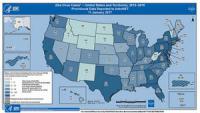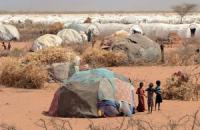-
Predicting Zika hot spots in the U.S.

Where in the continental United States is Zika most likely to occur? Researchers puts the bulls-eye of Zika transmission on the Mississippi delta. They also predicted the virus, which is spread sexually and by bites from the Aedes aegypti mosquito, is likely to be transmitted in southern states extending northward along the Atlantic coast and in southern California.
-
-
Famine: Nearly 1.4 million children at risk of death in Nigeria, Somalia, South Sudan, and Yemen

Famine is looming in north-east Nigeria, Somalia, South Sudan, Yemen, and beyond, as nearly 1.4 million children are at imminent risk of death from severe acute malnutrition this year. Some 22 million children are hungry, sick, displaced, and out of school due to war, conflict and drought. They now face the risk of death from starvation, but also from preventable diseases like cholera and measles, which cause severe diarrhea and dehydration. This crisis is largely human-made. Scorched earth tactics by conflicting parties are destroying crops and critical infrastructure like health facilities. Heavy fighting is forcing farmers to abandon their fields, while blocking humanitarian access to people in desperate need of food aid and clean water.
-
-
Under climate change, farming is becoming riskier
Climate change will have an impact on agriculture, but a new study puts these changes in terms which are directly applicable to farmers. For Illinois, for example, the corn planting window will be split in two to avoid wet conditions in April and May. Each planting window carries increased risk – the early planting window could be thwarted by frost or heavy precipitation, and the late window cut short by intense late-summer drought. Farmers and crop insurers must evaluate risk to avoid losing profits.
-
-
House, Senate committees approve agroterrorism bill
The U.S. House of Representatives Homeland Security Committee and U.S. Senate Homeland Security and Governmental Affairs Committee passed the Securing our Agriculture and Food Act, clearing a key hurdle for the bill’s consideration by the full House and Senate. The Securing our Agriculture and Food Act requires the Secretary of Homeland Security (DHS), through the Assistant Secretary for Health Affairs, to lead the government’s efforts to secure the U.S. food, agriculture, and veterinary systems against terrorism and high-risk events.
-
-
EPA awards $100 million to Michigan for Flint water infrastructure upgrades
The U.S. Environmental Protection Agency (EPA) last week awarded a $100 million grant to the Michigan Department of Environmental Quality to fund drinking water infrastructure upgrades in Flint, Michigan. The funding, provided by the Water Infrastructure Improvements for the Nation Act of 2016, or WIIN, enables Flint to accelerate and expand its work to replace lead service lines and make other critical infrastructure improvements.
-
-
Targeting of Syrian healthcare as “weapon of war” sets dangerous precedent: Experts

The strategy of using people’s need for healthcare against them by violently denying access sets a dangerous precedent that the global health community must urgently address, researchers say. As new estimates of death toll for health workers are published, experts say the deliberate and systematic attacks on the healthcare infrastructure in Syria – primarily by government forces – expose shortcomings in international responses to health needs in conflict.
-
-
Universal public coverage of 117 essential medicines would improve access, save billions
A list of 117 essential medicines — including antibiotics, insulin, heart medication, anti-depressants, oral contraceptives, and more — accounted for 44 percent of all prescriptions written in Canada in 2015, and up to 77 percent of all prescriptions when therapeutically similar medications were considered. Researchers calculated that publicly funding these 117 essential medicines could cover the cost of nearly half of all prescriptions in Canada, removing financial barriers for Canadians while saving $3 billion per year.
-
-
DHS-developed software powers humanitarian project
Software – called Krona — originally developed at the at the DHS’s National Biodefense Analysis and Countermeasures Center (NBACC) to sequence DNA for biodefense is now being used by Microsoft to sequence mosquito DNA in the fight against disease. Krona is a unique visualization tool that enables users to quickly analyze massive quantities of data — such as more than 100 million sequences of DNA in a single mosquito sample. Mosquitoes collect blood samples from every animal and human they bite and in turn can be an early warning indicator of disease. Microsoft is using Krona to analyze the complex DNA collected by mosquitos.
-
-
Looking for practices to thwart antimicrobial resistance
The death last year of a woman in Reno, Nevada, from an infection resistant to every type of antibiotic available in the U.S. highlights how serious the threat of antimicrobial resistance has become. Scientists are addressing growing global concern about the spread of antimicrobial resistance in Africa, where the World Health Organization predicts that, by 2050, drug resistant tuberculosis and other bacteria could lead to the deaths of 4.15 million people each year. Their work identifying practices that lead to bacterial transmission could help save African lives and prevent the spread of antibiotic resistant bacteria to the United States and other parts of the globe.
-
-
Lasers to keep poultry safe from avian bird flu
Last week, the British government has extended the avian influenza (bird flu) prevention zone to April 2017. Also, the requirements of the zone have changed, meaning keepers may let their birds out provided that they have enhanced biosecurity measures in place. One such biosecurity measure is an automated laser which repels unwanted – and potentially infected — birds without causing harm to the wild birds, the chickens being protected, and the surrounding environment.
-
-
Why farmers and ranchers think the EPA Clean Water Rule goes too far
President Trump issued an executive order 28 February directing federal agencies to revise the Clean Water Rule, a major regulation published by the Environmental Protection Agency and the Army Corps of Engineers in 2015. Framers and ranchers are particularly worried that the Clean Water Rule could expand federal regulations that impact their private property rights. However, regulatory agencies and the regulated community need to know the limits of the Clean Water Act’s reach so they can take appropriate measures to protect water resources. If the rule is scrapped, we still will need to know which water bodies require protection under the law. If the Trump administration withdraws or weakens the Clean Water Rule, it is likely to leave regulators interpreting case by case whether tributaries and adjacent waters are covered, as they have been doing since 2006, and land and water owners guessing about what they can do with their resources. So in the end, repealing the rule won’t answer the underlying question: how far upstream federal protection extends.
-
-
WHO issues list of bacteria for which new antibiotics are urgently needed
WHO today published its first ever list of antibiotic-resistant “priority pathogens” – a catalogue of twelve families of bacteria that pose the greatest threat to human health. The list was drawn up in a bid to guide and promote research and development (R&D) of new antibiotics, as part of WHO’s efforts to address growing global resistance to antimicrobial medicines.
-
-
Fewer grain dust explosions reported in U.S. in 2016
The number of grain dust explosions in the United States fell to a 10-year low in 2016, but two of the incidents resulted in the first reported fatalities since 2013, according to an annual report released by Purdue University’s Department of Agricultural and Biological Engineering. There were five grain dust explosions in 2016, compared to eight in 2015 and a 10-year average of 9.2 per year.
-
-
Global food production needs to keep increasing, but not as fast as previously thought
“Food production must double by 2050 to feed the world’s growing population.” This truism has been repeated so often in recent years that it has become widely accepted among academics, policymakers and farmers, but now researchers are challenging this assertion and suggesting a new vision for the future of agriculture. Production likely will need to increase between 25 percent and 70 percent to meet 2050 food demand – meaning that production needs to keep increasing, but not as fast as many have claimed.
-
-
Risk of Ross River Virus could be next global epidemic
Australia’s Ross River Virus (RRV) could be the next mosquito-borne global epidemic according to a new research. The virus has been thought to be restricted largely to Australia and Papua New Guinea where it is harbored by marsupial animals, specifically kangaroos and wallabies, and spread by mosquitoes. The research shows that the virus may have been circulating silently in the South Pacific ever since a large epidemic of more than 500,000 cases in 1979-80, thought to have been started by an infected Australian tourist who travelled to Fiji.
-
More headlines
The long view
A Shining Star in a Contentious Legacy: Could Marty Makary Be the Saving Grace of a Divisive Presidency?
While much of the Trump administration has sparked controversy, the FDA’s consumer-first reforms may be remembered as its brightest legacy. From AI-driven drug reviews to bans on artificial dyes, the FDA’s agenda resonates with the public in ways few Trump-era policies have.
